Explore Hua Hin - Thailand Travel, Asia
Hua Hin, located along Thailand's western Gulf Coast, is a picturesque beach town that seamlessly mixes history and modernity. Known for its pristine beaches, vibrant markets, and rich cultural heritage, Hua Hin has long been a favorite getaway for both locals and international travelers. What was once a sleepy fishing village has transformed into a lively resort destination, offering everything from luxury accommodations to authentic Thai experiences. Whether you're seeking relaxation on sandy shores or an adventure through bustling streets, Hua Hin promises a memorable escape.
Population: Approximately 66,000 in 2019.
Economy: Hua Hin's economy focuses on tourism, real estate, and agriculture. The town's vibrant tourism sector, coupled with growing property investments and local farming, supports its economic growth.
Landmarks: Famous for the Hua Hin Beach, Maruekhathaiyawan Palace, and Khao Takiab (or Chopstick Hill).
Thailand

Overview of Hua Hin
History & Cultural Influence
Hua Hin's history is a fascinating tapestry that traces back to the early 19th century. Originally a little fishing town, it rose to prominence in the 1920s when King Rama VII picked it as the location for his summer palace, Klai Kangwon, which means "Far from Worries." The town's cultural influences are derived from its royal background, and European-style architecture merges seamlessly with traditional Thai ones. Hua Hin is not just a beach destination; it’s a place where history lives on. The town's heritage, shaped by royal patronage and its role as a cultural hub, is evident in its temples, palaces, and local traditions that have been preserved over the years.
Interaction with the Locals
Hua Hin is home to a population of approximately 66,000 residents. The town's citizens are known for their warm hospitality and deep respect for tradition. The community is composed of both natives and expats, resulting in a varied and inclusive culture. While Thai is the primary language, many people in Hua Hin speak English, especially in tourist areas. The town’s laid-back vibe and friendly locals make it a popular destination for visitors looking to experience authentic Thai culture.
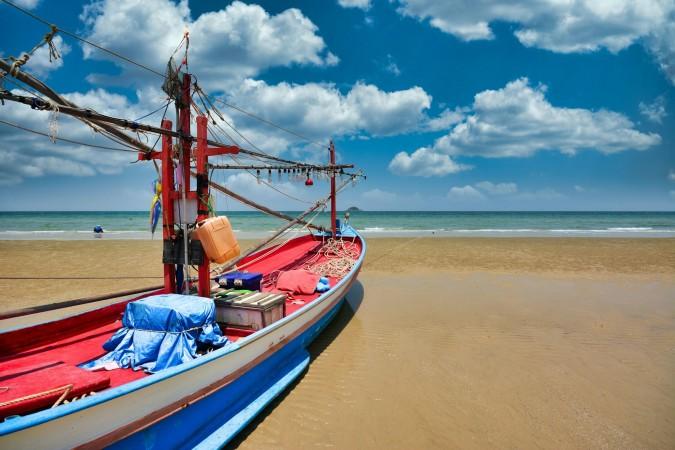
Hua Hin Beach - © allPhoto Bangkok
Top Attractions in Hua Hin
Hua Hin offers a variety of attractions that cater to all types of travelers. There's something for everyone, whether you want to relax on the beach, see historical places, or spend time outdoors.
Hua Hin Beach
Hua Hin Beach is the town’s main attraction, featuring a long stretch of soft, white sand. It's the ideal area to relax, swim, or try your hand at water activities such as kiteboarding. The beach is family-friendly, with gentle waves and plenty of space to relax under the sun.
Maruekhathaiyawan Palace
Known as "The Palace of Love and Hope," Maruekhathaiyawan Palace is a stunning example of Thai-Victorian architecture. Built in the 1920s, this royal summer retreat is set amidst beautifully landscaped gardens with sweeping views of the Gulf of Thailand. The palace’s intricate wooden design and breezy corridors offer a glimpse into the royal lifestyle of the past.
Khao Takiab (Chopstick Hill)
Khao Takiab, also known as Chopstick Hill, is a must-visit for those seeking both spiritual and scenic experiences. Atop the hill sits a revered Buddhist temple, where you can enjoy panoramic views of the Hua Hin coastline. The hill is also home to a troop of friendly monkeys, adding a playful element to your visit.
Pala-U Waterfall
Nature enthusiasts will love Pala-U Waterfall, located in the heart of Kaeng Krachan National Park. This multi-tiered waterfall is surrounded by lush tropical forest, offering excellent hiking trails and the chance to spot exotic wildlife. It's a peaceful retreat for individuals seeking to reconnect with nature.
Hua Hin Railway Station
One of the oldest and most beautiful railway stations in Thailand, Hua Hin Railway Station is a piece of living history. Its distinctive architecture, particularly the royal waiting room, reflects the town’s royal connections. The station is a charming reminder of Hua Hin’s past as a royal getaway.
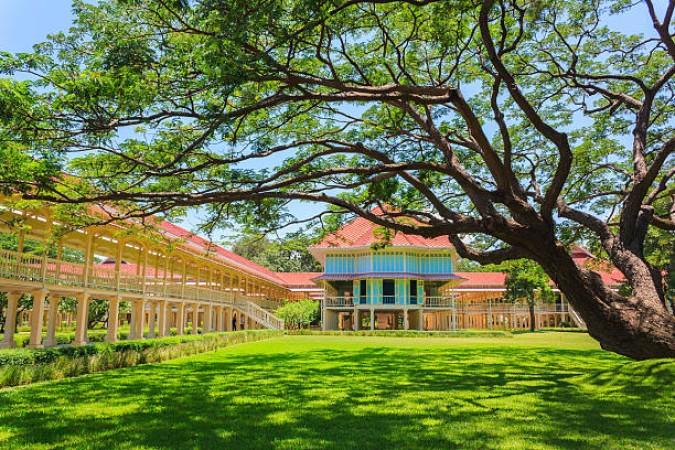
Maruekhathaiyawan Palace - © iStock
Must-Try Dishes in Hua Hin
Hua Hin is a culinary delight, offering an array of local dishes that showcase the best of Thai flavors.
- Hoy Tod (Crispy Oyster Omelette): Hoy Tod, a crispy omelet filled with fresh oysters, cooked on a hot griddle until crispy on the outside and soft inside, it’s topped with a tangy chili sauce.
- Kuay Teow Nam Sai (Clear Soup Noodles): Kuay Teow Nam Sai is a clear noodle soup with a flavorful broth, typically served with pork or chicken. Garnished with fresh herbs and bean sprouts, and enhanced with a squeeze of lime, this dish is light yet satisfying.
- Kanom Jeen Nam Ya (Fish Curry Noodles): Kanom Jeen Nam Ya features rice noodles topped with a spicy fish curry sauce. The curry is rich and aromatic, made with local herbs and spices, and is often served with fresh vegetables and herbs on the side.
- Som Tum (Green Papaya Salad): Som Tum is a tangy and spicy salad made from shredded green papaya, tomatoes, green beans, peanuts, and chili. It’s dressed with a mixture of lime juice, fish sauce, and palm sugar, creating a refreshing yet fiery flavor that’s perfect for balancing out richer dishes.
- Pad Thai: Pad Thai is a classic Thai dish of stir-fried rice noodles with a mix of ingredients like shrimp, chicken, tofu, eggs, and bean sprouts. Tossed in a tangy tamarind sauce and garnished with crushed peanuts and lime, this dish is both flavorful and satisfying.
- Khao Niew Mamuang (Mango Sticky Rice): Khao Niew Mamuang is a popular Thai dessert prepared with sweet sticky rice, juicy mango segments, and a drizzle of coconut milk. The combination of creamy, sweet, and slightly salty flavors makes it a perfect end to any meal.
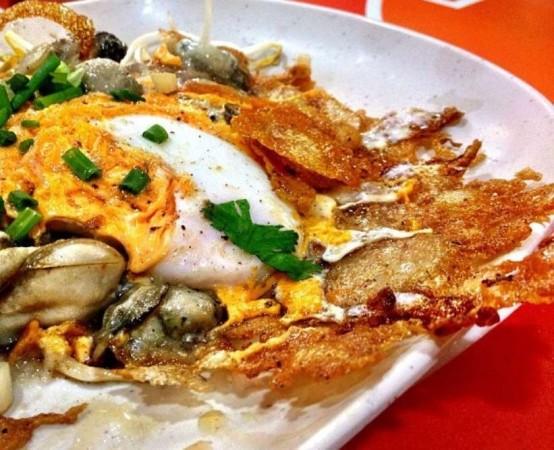
Hoy Tod (Crispy Oyster Omelette) - © Times of India
Festivals & Local Celebrations
Hua Hin hosts a variety of festivals and local celebrations throughout the year, offering visitors a chance to experience the town's rich cultural traditions.
Songkran Festival
The Songkran Festival, celebrated in mid-April, marks the Thai New Year and is one of Hua Hin’s most anticipated events. Known for its water-splashing festivities, Songkran is a time of fun and renewal. Locals and tourists alike take to the streets to participate in the water fights, symbolizing the washing away of the previous year’s misfortunes. It’s a joyous occasion that showcases the community spirit of Hua Hin.
Hua Hin Jazz Festival
Music lovers should not miss the Hua Hin Jazz Festival, an annual event that attracts both local and international jazz artists. Held on the beach, the festival features live performances against the backdrop of the sea, creating a unique and relaxed atmosphere. It’s a must-attend event for those looking to enjoy world-class music in a stunning setting.
Loy Krathong
Loy Krathong, usually celebrated in November, is a beautiful and serene festival where locals release floating lanterns (krathongs) into the water to pay respect to the water goddess. In Hua Hin, this festival is marked by colorful displays, traditional dances, and the gentle glow of thousands of lanterns on the water. It's an enchanting time to visit and partake in this beloved Thai custom.
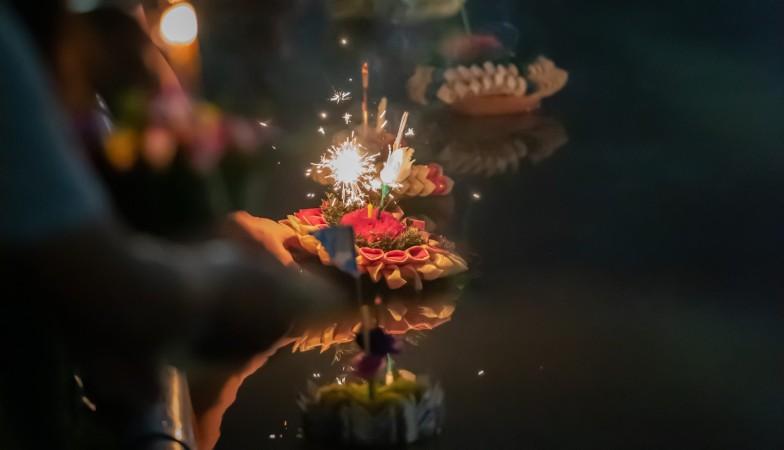
Loy Krathong in Hua Hin - © Hua Hin Today
What to Do in Hua Hin
- Beach Activities: The sandy shores of Hua Hin Beach are perfect for a variety of water sports, including jet skiing, paddleboarding, and kiteboarding. The calm waters also make it an ideal spot for swimming and sunbathing. For those who prefer a more laid-back experience, beachside massages are a popular way to unwind.
- Golfing Tours in Hua Hin: Hua Hin is a golfer’s paradise, with several world-class golf courses set against stunning backdrops. Courses like Black Mountain Golf Club and Banyan Golf Club offer challenging play and breathtaking views, making Hua Hin a top destination for golf enthusiasts.
- Night Market Exploration: Hua Hin’s night markets are a must-visit for anyone looking to experience the local culture. The Hua Hin Night Market and Cicada Market are two of the most popular, offering a mix of local crafts, souvenirs, and street food. Strolling through these bustling markets provides a glimpse into the town’s vibrant night scene.
- Temple Visits: Hua Hin is home to several beautiful temples that offer insight into Thai spirituality and culture. Wat Huay Mongkol, noted for its massive statue of respected Buddhist monk Luang Phor Thuad, is a tranquil refuge just outside of town.
Shopping in Hua Hin
- Hua Hin Night Market: The Hua Hin Night Market is a bustling hub of activity, where you can find a variety of products ranging from clothing and accessories to handcrafted items and artwork. The market is also a great place to sample local street food, making it a perfect evening outing.
- Cicada Market: Cicada Market is an open-air market that combines shopping with art and entertainment. It’s the go-to spot for unique handicrafts, paintings, and handmade jewelry. The market also features live music and performances, creating a lively atmosphere that attracts both locals and tourists.
- Bluport Hua Hin Resort Mall: For a more upscale shopping experience, Bluport Hua Hin Resort Mall offers a mix of international brands, dining options, and entertainment. The mall’s modern design and variety of stores make it a popular destination for those looking to shop in comfort.
- Plearnwan Vintage Village: Plearnwan is a vintage-themed shopping village that offers a nostalgic shopping experience. Designed to resemble a retro Thai village, Plearnwan is filled with shops selling vintage goods, traditional snacks, and souvenirs. It’s a great place to experience a bit of old-world charm while shopping for unique items.
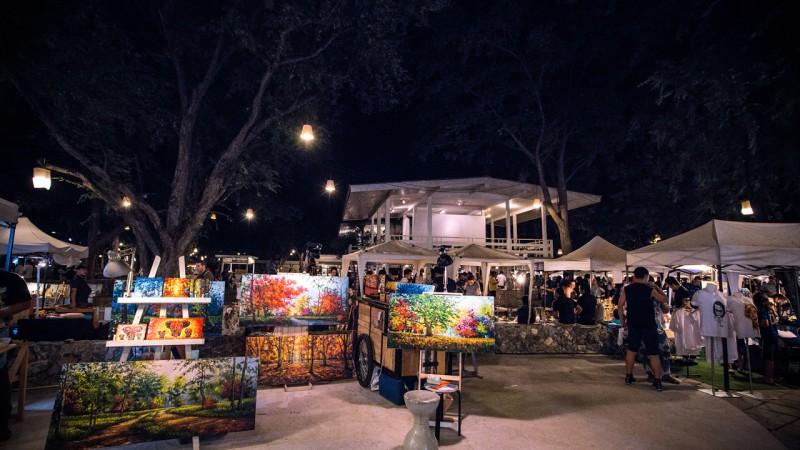
Cicada Market at night - © Thailand Tourism
Weather in Hua Hin: Best Time to Visit
Hua Hin’s climate is characterized by its tropical nature, offering distinct seasons that influence tourism trends.
Hot Season in Hua Hin
During the hot season, temperatures in Hua Hin can exceed 35°C (95°F), making it the warmest period of the year. This is an excellent time for beach enthusiasts and water sports aficionados who thrive in sunny, hot weather. The clean sky and brilliant weather are ideal for outdoor activities like swimming, jet skiing, and sunbathing. However, it's important to stay hydrated and use sun protection. This season is also popular for those looking to escape cooler climates.
Wet Season in Hua Hin
The rainy season brings occasional heavy showers and high humidity, with temperatures averaging around 30°C (86°F). While this period sees fewer tourists, it’s an ideal time for travelers seeking a quieter experience. The lush green landscapes and dramatic cloudscapes create a picturesque backdrop for photography and nature walks. Rainfall typically occurs in short bursts, often in the late afternoon or evening, leaving plenty of time for exploration. It's a good idea to pack waterproof gear and plan indoor activities during rain showers.
Cool Season in Hua Hin
The cool season offers the most pleasant weather for visiting Hua Hin, with temperatures ranging from 20°C to 30°C (68°F to 86°F). This is the peak tourist season, attracting travelers who prefer mild, comfortable temperatures for exploring outdoor attractions. The cooler weather is ideal for enjoying beach outings, golf, and sightseeing without the intense heat. This season is also popular for local festivals and outdoor events, adding to the vibrant atmosphere of Hua Hin.
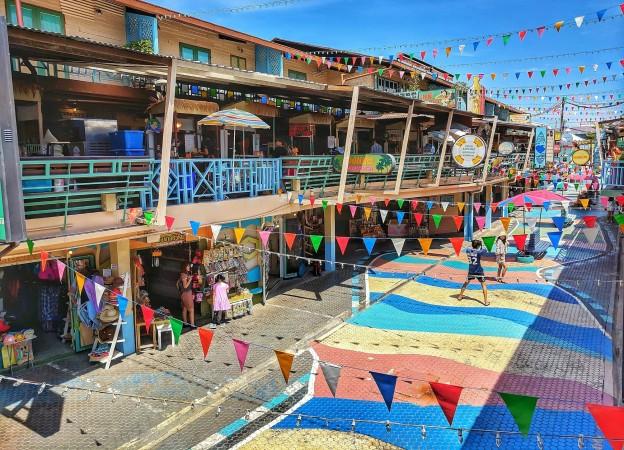
Hua Hin tourist's street on a clear day - © QUI NGUYEN
Essential Travel Information
Getting Around Hua Hin
- Taxis and Tuk-Tuks: Taxis and tuk-tuks are readily available and are a popular way to navigate the town. Taxis operate with meters, while tuk-tuks are often negotiated with fixed fares. Both offer an easy and flexible way to explore Hua Hin.
- Songthaews: Songthaews are shared pickup trucks that serve as local buses. They follow set routes and are an economical way to travel short distances. It’s common to hop on and off these vehicles at designated stops.
- Scooters and Bicycles: For greater freedom and flexibility, consider renting a scooter or bicycle. This is a great way to explore Hua Hin at your own pace and enjoy the town’s scenic spots.
- Public Buses: Public buses connect Hua Hin with nearby towns and attractions. They offer a budget-friendly option for longer trips and are a practical choice for travelers looking to explore beyond the town.
ATM & Banking Services
Managing your finances in Hua Hin is convenient with numerous ATM and banking services available. ATMs are scattered throughout the town, particularly in tourist areas and shopping centers, allowing easy access to cash in Thai Baht with international cards. For more comprehensive banking needs, various banks offer services including currency exchange and financial advice. Credit and debit cards are widely accepted in most establishments, but carrying some cash is advisable for smaller vendors and markets.
Where to Stay in Hua Hin
- Luxury Resorts: For those seeking a high-end experience, Hua Hin features several luxurious resorts that provide top-notch amenities and prime beachfront locations. These resorts typically offer expansive rooms or villas, exceptional service, and facilities like swimming pools, spas, and fine dining restaurants.
- Mid-Range Hotels: Travelers looking for comfort at a more affordable price will find numerous mid-range hotels in Hua Hin. These establishments offer a balance of quality and value, with amenities such as swimming pools, on-site dining, and convenient locations, making them ideal for both relaxation and exploration.
- Boutique Hotels: Boutique hotels in Hua Hin offer a unique and personalized experience, often featuring distinctive decor and intimate atmospheres. These hotels provide stylish accommodations and a more personalized service, perfect for those seeking a charming and memorable stay.
- Budget Guesthouses: For budget-conscious travelers, Hua Hin has a variety of guesthouses and hostels that offer basic yet comfortable accommodations. These options provide essential amenities at lower rates, making them suitable for those looking to save on accommodation while still enjoying a pleasant stay.
Articles for you

Explore Yala National Park - Sri Lanka Travel, Asia
Tucked away in Sri Lanka’s southeastern corner, Yala National Park is where wild nature meets deep tradition. Known worldwide for its leopard population, the park is also home to elephants, sloth bears, crocodiles, and hundreds of bird species. Beyond wildlife, Yala opens doors to a cultural landscape dotted with ancient temples, Buddhist ruins, and coastal villages. For travelers seeking more than just a safari, Yala offers a chance to explore eco-tourism, local communities, and sacred heritage sites.
Population: The Yala National Park area doesn’t have a human population.
Economy: The economy around Yala National Park thrives on a blend of eco-tourism, agriculture, and local services. Safari tours, eco-lodges, and cultural experiences drive steady income for nearby towns like Tissamaharama and Kataragama, supporting thousands of families.
Landmarks: Famous for Block I of Yala and wildlife encounters, including elephants, sloth bears, crocodiles, and exotic bird species.

Explore Galle - Sri Lanka Travel, Asia
Nestled on Sri Lanka’s southern coastline, Galle is a vibrant city where history meets the sea. Its cobbled streets, colonial architecture, and serene beaches make it a must-visit destination for travelers seeking a blend of culture, adventure, and relaxation. A UNESCO World Heritage site, Galle captivates visitors with its Dutch Fort, bustling markets, and friendly locals. Whether you’re exploring the ramparts at sunset or savoring fresh seafood by the shore, Galle promises an unforgettable journey into Sri Lanka’s heritage.
Population: Approximately 113,000 in 2023.
Economy: Galle’s economy thrives on tourism, trade, and fisheries. The city’s historic fort, colonial architecture, and coastal charm draw thousands of international visitors each year, making tourism its main economic driver. Fishing remains vital for local livelihoods, supplying fresh seafood across the region.
Landmarks: Famous for the Galle Fort, Dutch Reformed Church & Maritime Museum, and Unawatuna Beach.

Explore Bentota - Sri Lanka Travel, Asia
Nestled along Sri Lanka’s southwestern coast, Bentota is a tropical paradise that blends golden beaches, vibrant culture, and thrilling adventures. Famous for its calm waters, luxury resorts, and scenic river estuary, Bentota has become a top destination for travelers seeking both relaxation and authentic experiences. From serene beach walks at sunrise to adrenaline-pumping water sports, this coastal town offers a perfect balance of leisure and exploration. With its proximity to Colombo and Galle, Bentota is easy to reach, making it an ideal stop for both short escapes and extended holidays.
Population: Approximately 37,000 in 2023.
Economy: Bentota’s economy thrives mainly on tourism, which drives local businesses such as hotels, restaurants, and wellness retreats. The town also benefits from fishing, coconut cultivation, and handicrafts like wood carving and batik textiles. Many residents rely on the growing demand for water sports and Ayurvedic treatments, making tourism the backbone of both income and employment in the area.
Landmarks: Famous for Bentota Beach, Bentota River Safari, and Kande Vihara Temple.

Explore Mirissa - Sri Lanka Travel, Asia
Mirissa is a charming coastal town on Sri Lanka’s southern shoreline. Known for its golden beaches, turquoise waters, and vibrant marine life, it has become a must-visit stop for travelers exploring the island. Many come for whale watching, surfing, and sunset views at Coconut Tree Hill, but Mirissa offers much more than postcard beauty. The fishing boats you see anchored by the bay carry generations of stories. Local traditions, delicious cuisine, and a laid-back rhythm of life shape every visitor’s experience.
Population: Approximately 4,700 in 2023.
Economy: Mirissa’s economy is largely shaped by its coastal location. Fishing has long been the backbone of local livelihoods, with generations relying on the Indian Ocean for income. In recent decades, tourism has become the main driver of growth, thanks to whale watching, surfing, and beachside hospitality.
Landmarks: Famous for Mirissa Beach, Coconut Tree Hill, and Parrot Rock Bridge.

Explore Nuwara Eliya - Sri Lanka Travel, Asia
Tucked away in the Central Highlands of Sri Lanka, Nuwara Eliya is often called “Little England”. With its rolling tea plantations, cool misty mornings, and colonial charm, this mountain town feels like a step into another world. Travelers come here to breathe fresh air, walk through flower gardens, sip the finest Ceylon Tea, and enjoy a pace of life far from the island’s busy cities. Whether you’re drawn by scenic landscapes, heritage architecture, or the warmth of its people, Nuwara Eliya is a destination that blends nature, culture, and history in perfect harmony.
Population: Approximately 781,000 in 2023.
Economy: Nuwara Eliya’s economy thrives mainly on tea production, as it sits in the heart of Sri Lanka’s central highlands, famous worldwide for Ceylon Tea. The city also benefits from a growing tourism industry, attracting visitors with its colonial charm, cool climate, and scenic landscapes.
Landmarks: Famous for Gregory Lake, Hakgala Botanical Garden, and Victoria Park.

Explore Sukau - Malaysia Travel, Asia
Nestled on the banks of the Kinabatangan River in Sabah, Malaysian Borneo, Sukau is a destination where wildlife, culture, and conservation come together. Known as one of Asia’s top spots for river safaris and eco-tourism, this quiet village offers a front-row seat to encounters with Bornean orangutans, pygmy elephants, proboscis monkeys, and exotic birdlife.
Population: Approximately 1,400 in 2019.
Economy: Sukau’s economy is shaped by its riverine location and natural resources. Traditionally, the Orang Sungai community relied on fishing, small-scale farming, and forest gathering for their livelihood. Today, the village has shifted toward eco-tourism, with river cruises, jungle trekking, and homestays providing income.
Landmarks: Famous for the Kinabatangan River cruises, Gomantong Caves, and Ox-bow lakes and wetlands.
